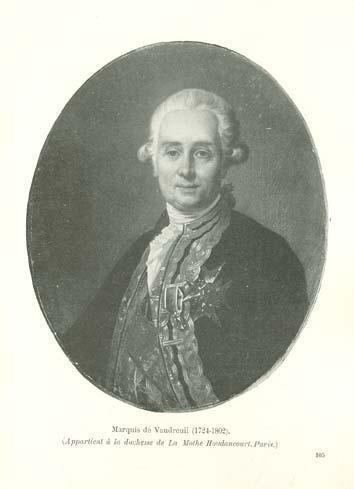Years of service 1778-1783 Name Louis-Philippe Vaudreuil Service/branch French Navy | Unit Spectre, Triomphant Awards Order of Saint Louis Allegiance France | |
 | ||
Born 28 October 1724
Rochefort, France ( 1724-10-28 ) Rank Admiral, second only to Count de Grasse Battles/wars American Revolutionary War
Second Battle of Cape Finisterre (1747)
First Battle of Ushant
Battle of the Chesapeake
Siege of Yorktown
Battle of the Saintes
Protection of Boston Harbour Died December 14, 1802, Paris, France Similar People Francois Joseph Paul de G, Jean‑Baptiste Donatien de Vimeu, George Washington, George Brydges Rodney, Charles O'Hara | ||
Louis-Philippe de Rigaud, Marquis de Vaudreuil (28 October 1724 – 14 December 1802) was second in command of the French Navy during the American Revolutionary War.
Contents
Early life
Louis-Philippe was born into a family with a rich political and military tradition. His grandfather, Philippe de Rigaud de Vaudreuil, and his uncle Pierre de Rigaud de Vaudreuil de Cavagnal, were both governors of Canada; the latter was its last governor, surrendering Montreal to the British in 1760. Another uncle, Pierre-Francois de Rigaud, fought with Montcalm at the Battle of Oswego.
His father, also named Louis-Philippe de Rigaud de Vaudreuil, was a celebrated admiral of the French Navy, and was in charge of the navy in North America in 1747. Louis-Philippe the elder successfully saved Desherbiers de l'Etenduere at the Second battle of Cape Finisterre while commanding the Intrepide. Louis XV himself ordered the celebrated Dutch artist Charles-Andre van Loo to paint one of his naval battles; this painting is still in the Palace of Versailles.
Although his father was born in Quebec City and there are claims that Louis-Philippe the son was born in Canada, it is more probable that he was born in Rochefort, France, as his father was in charge of that city on the west coast of France at the time.
American Revolutionary War
Vaudreuil was dispatched to America when the French entered the war on the side of the Americans in February 1778. His first engagement came at the First Battle of Ushant, an island on the north-west part of France near Brest, where the French Navy and the British Navy fought to a draw. He was at sea for about five months.
Vaudreuil was on the Sceptre in the Battle of the Chesapeake. After one furious engagement with the British navy, Admiral de Grasse's fleet and the British fleet drifted for miles south of Yorktown and lost sight of each other. De Grasse eventually disengaged and returned to the Chesapeake, where he met the fleet of the Comte de Barras. This combined fleet outnumbered the British fleet, and gave the French control of the bay when the British opted not to attack. This had the effect of cutting the army of Cornwallis off from resupply and relief, leading to the Siege of Yorktown and his surrender. Vaudreuil's contribution to this effort was to provide the cavalry of Duke of Lauzun, a foreign legion that was a mix of Russian, Slavic, Polish and German mercenaries in the service of France. He also provided eight hundred men from his ship to Gloucester Point in defence of a peninsula near Yorktown. Together with the Duke of Lauzun these men fought the cavalry of Tarleton, and defeated him.
In the 1782 Battle of the Saintes, Vaudreuil was credited with saving most of the French Navy's ships in the disastrous defeat. Since De Grasse was taken prisoner Vaudreuil took command of the entire French fleet in America. Afterward, Vaudreuil was on the ship Triumphant in Boston harbour. At the conclusion of the war in 1783, he was responsible for bringing the victorious French army of Rochambeau back to France.
French Revolution
Vaudreuil, with other Naval officers, forced his way into the Palace of Versailles on the night of October 5–6 to protect the Royal family. He then emigrated to London in 1791, returning to Paris in 1800. Upon returning, he was granted a Naval pension by Napoleon.
